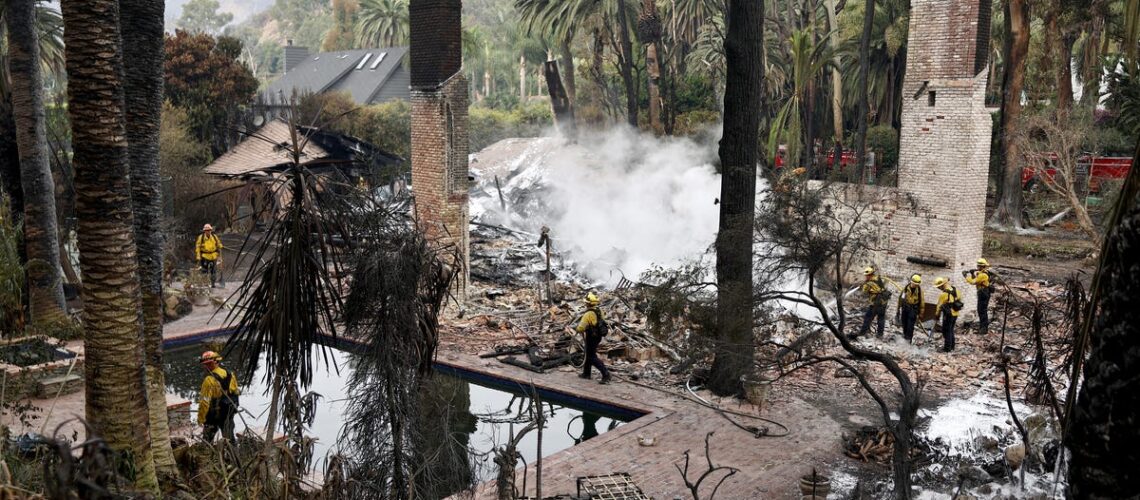LA fires endanger California home insurance market: What to know
January 10, 2025

- Congress must stop heartbreak insurance companies cause
- Congressional Report Warns of Climate Threat to US Insurance, Housing Markets
- California overhauled its insurance system. Then Los Angeles caught fire.
- Three men sentenced for ‘crash for cash’ fraud
- Best Whole Life Insurance Companies for December 2024
Tips for homeowner’s insurance claims during the California wildfires
Bạn đang xem: LA fires endanger California home insurance market: What to know
As wildfires rage through Southern California, here is what residents should know about filing insurance claims.
As firefighters race to control roaring blazes that have forced thousands to flee their homes, the mounting financial toll from the most destructive firestorm in Los Angeles history could deal a devastating blow to the property insurance market and the California homeowners who rely on it.
The impact of the catastrophic wildfires could drive up already sky-high premiums and prompt a new wave of private insurers dropping policies or declining to write new ones – and not just in the LA area.
“Insurance is going to be even harder to come by and it is going to get incredibly more expensive than it already is. People need to be prepared for that,” said Mark Newman-Kuzel, president and owner of The Mark Newman-Kuzel Agency in Los Angeles, who said at least six of his clients have lost their homes so far and many more have called to check on their insurance coverage. “As I tell my clients when they do their annual policy reviews, you are lucky you weren’t canceled.”
With economic losses already topping an estimated $135 billion, consumer advocates warned the state’s insurer of last resort for many homeowners, known as the FAIR Plan, could run out of funding, forcing it to draw money from private insurers operating in the state to recoup its losses and making it even more challenging for homeowners to find affordable coverage.
“We are very worried about how this situation is going to impact availability and affordability going forward,” said Amy Bach, executive director of United Policyholders, a consumer advocacy group.
How will the wildfires affect California’s insurance market?
Insurers pulled back from California after severe wildfires in 2017 and 2018 hit profits, leaving homeowners struggling to find affordable coverage. A San Francisco Chronicle analysis of insurance data found more than 100,000 Californians lost coverage between 2019 to 2024. Last summer, over 1,600 policies for homeowners in Pacific Palisades, one of the areas affected by fires, were dropped by State Farm.
Xem thêm : RiverStone International to Provide Loss Portfolio Transfer for Zurich Insurance
“The industry is still in a period of recovery from wildfires that happened in 2017, 2018, and here we are at the start of 2025,” said Tim Zawacki, principal research analyst for insurance at S&P Global Market Intelligence. “The wound is pretty deep, and I think the industry will continue to view this market with a high degree of caution.”
Things were looking up for California’s insurance market heading into 2025. The California Department of Insurance announced new regulations last month to convince insurers to take on new customers in high-risk areas, allowing them to pass along reinsurance costs to customers and use wildfire catastrophe modeling to raise rates.
The new rules should lead to a “more competitive insurance market,” according to Janet Ruiz, a California-based spokesperson for the Insurance Information Institute. Farmers Insurance last month announced plans to expand coverage in the state.
But some say the new regulations may not be enough to convince insurers to remain in California, especially after this week’s deadly wildfires, which have destroyed more than 4,000 structures.
High claim payouts, “plus the visual images of the destruction, are going to haunt C-Suite executives and likely temper the renewed enthusiasm for insuring (California) homes that we’ve been counting on the reforms to bring,” Bach said.
AccuWeather experts estimate the total damage and economic loss to fall between $135 billion and $150 billion, with chief meteorologist Jonathan Porter on Thursday saying the “wind-driven infernos have created one of the costliest wildfire disasters in modern U.S. history.”
A J.P. Morgan report said the “vast majority” of losses are expected to be concentrated in homeowners’ insurance, with both primary insurers and reinsurers experiencing “sizeable losses.”
“We’re staring a real crisis in the face,” said David Russell, an insurance and finance professor at California State University. “The commissioner’s office is going to have to grant these rate increases, otherwise the availability problem is going to be much more severe.”
Denni Ritter, department vice president of state government relations for the American Property Casualty Insurance Association, a national trade group for insurers, said it’s too early to speculate on the wildfires’ impact on the market.
“Recent reforms to stabilize California’s insurance market are important, but they have yet to be finalized or implemented,” Ritter said.
Others have downplayed the effects the recent wildfires could have on insurers’ presence in the state.
Xem thêm : Average Insurance Costs for 5 Tesla Models — They Might Surprise You
“The insurance industry understands that we’re going to have catastrophes and wildfires. The plans that we made through this Sustainable Insurance Strategy take all of that into consideration,” said Ruiz from the Insurance Information Institute. “One catastrophe wouldn’t necessarily change anything that we are already putting into place.”
What does this mean for California’s FAIR Plan?
More homeowners have turned toward California’s insurer of last resort, the FAIR Plan, in recent years. The insurer has higher premiums and limited coverage, but its user base has skyrocketed as homeowners struggle to find coverage from the private market.
As the economic losses from wildfires continue to grow, there are concerns that the FAIR Plan may need to turn to the primary insurers operating in the state for funding, pushing more insurers to leave the state.
“When you’re having to bail out another insurer as a private insurer, you start to consider whether or not it’s attractive to be in that location,” Russell said. “This is an off-cycle set of claims. What happens when we’re back in fire season in the summer and fall if the FAIR Plan is already under water?”
The total value of properties insured by the FAIR Plan totaled more than $458 billion as of September, up from $153 billion in 2020, according to the insurer’s website. Nearly $6 billion worth of property is in Pacific Palisades.
“We are one event away from a large assessment, there’s no other way to say it, because we don’t have a lot of money on hand, and we have a lot of exposure out there,” California FAIR Plan President Victoria Roach said during a state hearing in March.
While it is too early to offer loss estimates from the most recent fires, spokesperson Hilary McLean said the FAIR Plan “has payment mechanisms in place, including reinsurance, to ensure all covered claims are paid.”
The insurer has been a “critical insurance option” for many California residents, according to Michael DeLong, a research and advocacy associate at the Consumer Federation of America, a consumer advocacy group.
“It may need more funds. It may need additional support. But without it, California homeowners will be in an even worse situation,” DeLong said.
(This story has been updated with additional information.)
Nguồn: https://propertytax.pics
Danh mục: News
